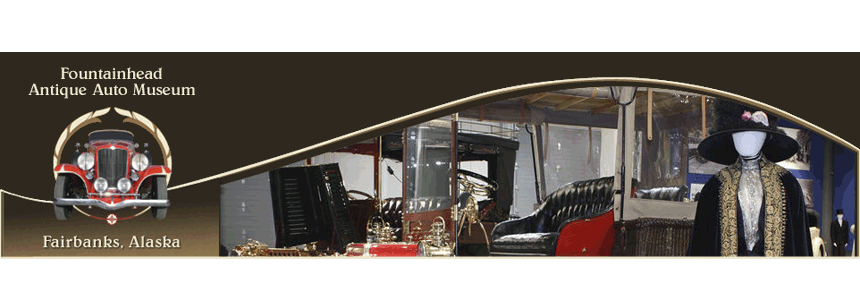© Fountainhead Antique Auto Museum
 |
| Photo courtesy of Candy Waugaman |
 Not surprisingly, many old Alaskan photos show people clad in fur coats. By the 1920s, full-length raccoon coats (like our example at left) had become quite popular in the States, especially among male college students and automobilists of both sexes. Of course, Alaskan pioneers had already been wearing coats made from raccoon, beaver, bear and wolf out of necessity for years (and Alaska Natives for centuries before that).
Not surprisingly, many old Alaskan photos show people clad in fur coats. By the 1920s, full-length raccoon coats (like our example at left) had become quite popular in the States, especially among male college students and automobilists of both sexes. Of course, Alaskan pioneers had already been wearing coats made from raccoon, beaver, bear and wolf out of necessity for years (and Alaska Natives for centuries before that).Many fashionable coats of the 1920s had large shawl collars and enormous cuffs trimmed with fur from fox, sable, ermine, mink, chinchilla, Persian lamb or even monkey. As the decade progressed, women's coat styles became less fitted, with belts dropping from the natural waist to the hips, and then disappearing altogether. A common style was the cocoon coat, which fit loosely on top and narrowed at or near the knees.

 Elegant wraps, especially the oriental-style evening coats popularized by designer Paul Poiret, were a favorite among flappers. Few had snaps, hooks or buttons, as they were meant to be worn open. Common fabrics included silk, velvet, satin, lamé, and gold and silver brocades. Many had large, kimono sleeves and were decorated with embroidery, tassels, metallic braids, fur or even jewel beetles, like this coat we have on display. The sleeves and hem on the reversible lamé coat at left are trimmed with what looks like monkey fur, but is actually tufted silk. Does anyone else think this coat could be a Poiret creation?
Elegant wraps, especially the oriental-style evening coats popularized by designer Paul Poiret, were a favorite among flappers. Few had snaps, hooks or buttons, as they were meant to be worn open. Common fabrics included silk, velvet, satin, lamé, and gold and silver brocades. Many had large, kimono sleeves and were decorated with embroidery, tassels, metallic braids, fur or even jewel beetles, like this coat we have on display. The sleeves and hem on the reversible lamé coat at left are trimmed with what looks like monkey fur, but is actually tufted silk. Does anyone else think this coat could be a Poiret creation?

Another common cover for evening wear was a lightweight wrap, cape or shawl made of silk, chiffon, rayon or tulle. Many featured beautiful embroidery or beading in floral, Art Deco or Egyptian motifs--the latter attributed to the public's fascination with the discovery of King Tut's tomb in 1922. Fringe or macramé was common on the lower edge of shawls.
We hope you'll visit and check out the lovely historic outerwear we have on display. Our fashion curator frequently puts new pieces out on display, so you never know what treasures you might encounter!


No comments:
Post a Comment
Blogging about the Fountainhead Antique Auto Museum's latest news, adventures and research